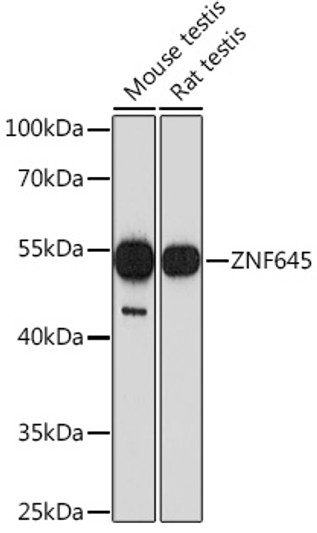| Host: | Rabbit |
| Applications: | WB/ELISA |
| Reactivity: | Mouse/Rat |
| Note: | STRICTLY FOR FURTHER SCIENTIFIC RESEARCH USE ONLY (RUO). MUST NOT TO BE USED IN DIAGNOSTIC OR THERAPEUTIC APPLICATIONS. |
| Clonality : | Polyclonal |
| Conjugation: | Unconjugated |
| Isotype: | IgG |
| Formulation: | PBS with 0.01% Thimerosal, 50% Glycerol, pH 7.3. |
| Purification: | Affinity purification |
| Concentration: | Lot specific |
| Dilution Range: | WB:1:500-1:2000ELISA:Recommended starting concentration is 1 Mu g/mL. Please optimize the concentration based on your specific assay requirements. |
| Storage Instruction: | Store at-20°C for up to 1 year from the date of receipt, and avoid repeat freeze-thaw cycles. |
| Gene Symbol: | CBLL2 |
| Gene ID: | 158506 |
| Uniprot ID: | CBLL2_HUMAN |
| Immunogen Region: | 346-425 |
| Specificity: | Recombinant fusion protein containing a sequence corresponding to amino acids 346-425 of human ZNF645 (NP_689790.1). |
| Immunogen Sequence: | QNGNPSASEFASHHYNLNIL PQFTENQETLSPQFTQTDAM DHRRWPAWKRLSPCPPTRSP PPSTLHGRSHHSHQRRHRRY |
| Tissue Specificity | Exclusively expressed in testis and sperm, including spermatocytes, round and elongated spermatids, and Leydig cells. |
| Function | E3 ubiquitin ligase catalyzing the covalent attachment of ubiquitin moieties onto substrate proteins. May operate on tyrosine-phosphorylated SRC substrates. |
| Protein Name | E3 Ubiquitin-Protein Ligase Cbll2Cbl Proto-Oncogene-Like Protein 2Ring-Type E3 Ubiquitin Transferase Znf645Zinc Finger Protein 645C-Cbl-Like Protein 2 |
| Database Links | Reactome: R-HSA-983168 |
| Cellular Localisation | CytoplasmLocalized Over The Postacrosomal Perinuclear Theca Region And The Entire Length Of Sperm Tail |
| Alternative Antibody Names | Anti-E3 Ubiquitin-Protein Ligase Cbll2 antibodyAnti-Cbl Proto-Oncogene-Like Protein 2 antibodyAnti-Ring-Type E3 Ubiquitin Transferase Znf645 antibodyAnti-Zinc Finger Protein 645 antibodyAnti-C-Cbl-Like Protein 2 antibodyAnti-CBLL2 antibodyAnti-ZNF645 antibody |
Information sourced from Uniprot.org









